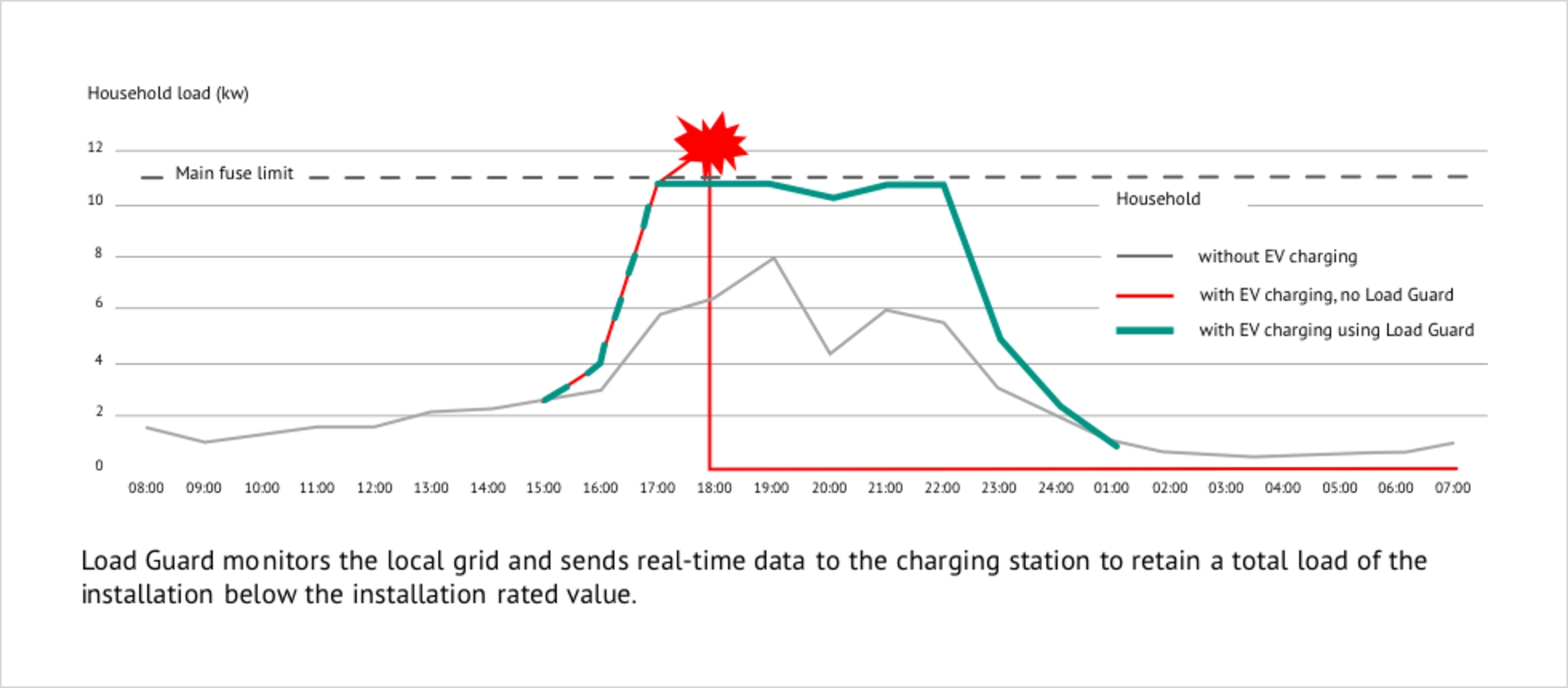The number of electric vehicles (EVs) is growing and charging them, if not done in a smart way, could cause various problems. These problems include an overload of the electrical connection within one building or street, and even an unwanted overload of the entire electricity system. The help is offered by various smart energy management solutions, which can limit the performance of chargers or other appliances or manage additional energy sources to offset the increased consumption.
EV chargers have a nominal power from 3 kW (slow) through 50 kW (fast), up to 350 kW (ultra-fast). Placing multiple chargers at one location could mean adding up their nominal powers to determine the required grid connection capacity. However, this would, especially in the case of larger residential or commercial buildings, lead to unbearable requirements for the local electrical network and for the charged reserved connection capacity. However, the use of chargers is almost never 100%. Slow chargers are used at night or during working hours and it is usually not necessary to supply power all the time when the EV is connected. Fast and ultra-fast chargers are only used for a short time, and on the contrary, it is desirable that they work at their nominal power if EV can accept it. All this provides room for optimization. With proper management, individual chargers within one location can deliver their power gradually, according to predefined priorities, and at the same time, all EVs will be charged at the required time with minimized charging costs.
Smart charging has several economic benefits:
- Reducing the cost of electrical wiring, including the main grid connection of the building
- Reduction of monthly fees for reserved capacity
- Enabling the use of a cheaper electricity price (with a variable tariff)
- Optimization of own consumption from renewable energy sources
- Enabling monetization of flexibility through aggregator services
Summary: Smart charging ensures that EVs are charged at the required time, at a good price, and with respect to the technical and contractual parameters of the grid connection.
Dynamic Load Management
Dynamic Load Management is an effective tool that increases the speed and safety of EV charging.
DLM principle is a continuous measurement of the power supplied by the grid connection and, if the limit value is reached, a temporary limitation of the power of the chargers without interrupting the charging process. Today, almost every charger manufacturer offers some form of DLM.
A specific example of DLM is Load Guard from ETREL. It is an intelligent energy meter that can real time send the measured values to ETREL charging stations, which change their actual power output accordingly.
Load Guard is compatible with INCH Wallbox and INCH Duo chargers from Etrel and cannot be applied to chargers from other manufacturers. Generally, although there is no universal DLM solution applicable to all chargers currently available on the market, there are already several DLM solutions that can control chargers from several manufacturers or even a group consisting of several DC and AC chargers.
In case of more charging stations on one grid connection, the Cluster could be created, where in which one station (master) controls the other (slaves). There are several options for connecting chargers to Load Guard (WiFi, PLC), but the most frequently used is cable connection (ethernet), which is the most stable. Security is also increased by the application of the fail-safe mode, i.e. safe power consumption limit for situation of loss of communication between the charging station and its master station or Load Guard.

Load Guard – Connection via Ethernet
https://etrel.com/charging-solutions/load-guard/
Load Guard is especially important for situations where charging stations do not have a separate grid connection but share the available power with other appliances in the building. Based on the instantaneous measured power at the input, the Load Guard constantly sets the actual power of the charging stations to the required value so that the connection limit is not exceeded. The response speed of the system with Load Guard to a change in input power is in the range of 10-30s, which is fast enough, as the tripping characteristics of the circuit breakers to a slight overload are longer.

Load Guard – overload protection
https://etrelchargingsolutions.atlassian.net/wiki/spaces/Home/pages/257228872/Etrel+Load+Guard
Load Guard is usually installed in the main switchboard, i.e. at the input of the grid connection to the building. An alternative is its installation in a secondary switchboard from which the charging stations are powered, but in that case it is necessary to determine the value of power that this switchboard will always have available for all its connected appliances.
For electric current measurement, measuring transformers of current with a maximum value of either 150 A (for conductors up to a diameter of 16 mm2) or 400 A (for conductors up to a diameter of 24 mm2) are used.

Load Guard – example of connection layout for the main switchboard of house